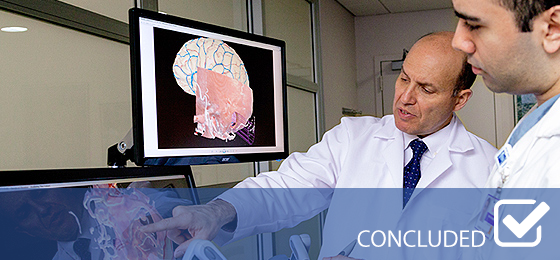Virtual Surgical Simulation
For decades, simulation has been used to train novice airline pilots and young drivers, and the AO Foundation today is assessing the possibility of using simulation to train surgeons. In phase one of the AO Foundation Multipurpose Virtual Surgical Simulation Trainer project, funded by a Strategy Fundgrant, AO CMF, AO North America, and the Imperial College London are taking a close look at simulation technology and providers, with an eye to enabling the AO to become a leading player in virtual surgical simulation.
Project leader Dr Tobias Hüttl, said surgical simulation is still in its infancy, but demand is growing.
"Within the approach to surgical training, there is a movement away from the classical training model towards acquiring technical skills through simulation," said Hüttl, Executive Director of AO CMF and AO VET. "Prohibitive cost and limited availability of donors make it more and more difficult today to do specimen-based education. At the same time, with increased focus on patient safety, stricter regulations and reduction of duty hours for surgical trainees, the apprenticeship model of training surgeons has become inadequate for ensuring acquisition of sufficient skills."
Times are changing
Historically, surgical residents spent a lot of time in the operating room gaining exposure to treatment techniques, but that is changing.
"Today, trainees' working hours are highly regulated and they are getting less exposure time to procedures, and patients are less willing to accept treatment by rookie surgeons," he said. "If you define the right metrics for simulation, it can offer many advantages. For example, you can precisely measure the trainees’ knowledge and performance and even simulate patient outcomes based on the trainees’ performance on the simulator."
In the assessment phase, the project team is examining the current surgical simulation landscape, the needs of surgeons at various levels of training, the flexibility of available solutions to be adjusted in terms of quality and cost to surgeons' training needs, and legal and compliance issues around simulation-based training.
Fulfilling the AO mission
The cross-divisional project ultimately will have a direct impact on patient care, helping to fulfill the AO’s mission.
"It will ensure the AO’s leadership role in musculoskeletal surgical education and have an impact on the AO’s perception and reputation as an innovative, leading-edge educational and research organization," Hüttl said.
However, Hüttl cautioned, the AO’s steps into surgical simulation training must be taken with care.
"The one thing worse than having no simulator, would be having one that is badly done. The assessment we are doing includes the evaluation of the current unmet needs in surgical simulation in all AO Clinical Divisions," he explained. "After the assessment, we would start with a very basic approach and identify the most critical surgical procedures to be simulated, based on what the surgeons say is needed."
Without support from the Strategy Fund, it’s unlikely the assessment would have gotten off the ground, Hüttl said.
"I don’t see how we would have had the resources anywhere," he said. "To me, this is a really exciting project because it could be the next level of teaching. If we have a really good simulator training surgeons on the critical steps of surgical procedures, it could be a tremendous opportunity for every surgeon—and for the AO."
Contact
Please contact the Strategy Fund team at techtransfer@aofoundation.org


